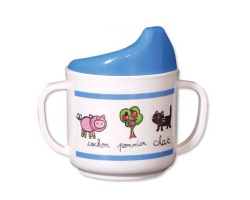How can I reuse or recycle combs?
 Janet has asked us a question on the Suggest an Item page:
Janet has asked us a question on the Suggest an Item page:
I have several combs that I don’t use. Can they be re-used or recycled?
Any unrequired combs found in our house are cleaned then used for cat/dog brushing – they seem to prefer combs to brushes, and their combs go missing with startling regularity (if they were smarter animals, I’d suspect they were hiding them on purpose).
Handle-less combs, the type used for holding hair in place rather than untangling it, can used as the base of a fascinator or decorate it with old jewellery or fabric scraps on a smaller scale for use as a day-to-day hair accessory.
As for actually recycling it, it’ll depend on the material they’re made from. From what I’ve been able to find online, a lot of (modern) plastic combs seem to be made from injection moulded polypropylene (plastic number 5), which can be recycled – but not everywhere collects it and even the places that do often only take it in certain common forms. Most every-day metal ones are steel.
Any other reusing ideas? Or recycling advice?
























I’ve seen combs used in simple weaving, especiallyn children’s projects, to beat down the weft, especially on strip weaving. I wonder if a simple strip loom could be made using the comb to hold the warp.
Old combs can be donated to animal shelters. You can call local shelters or senior centers and beauty schools to find out where you can donate them but as simple as it sounds, combs male EXCELLENT entertainment for children! Pour a cup or two of play sang in a dinner tray, shallow baking tray or storage bin! Let kiddies comb designs in the sand!!! It’s a HUGE fascination for toddlers!
Please do donate them to an animal shelter or to friends with many dogs and cats — combs are better than brushes when it comes to matted or wet hair, and we do need them for grooming and flea/tick removal purposes.
If the combs are clean and new-ish, you can see if the local homeless shelter would like them. I work with refugees and you would be surprised at the kinds of things they need and will gladly accept secondhand — towels, pots and pans, clothes, combs, hotel shampoo bottles, etc.
You can also donate them to a school or kindergarten for the children’s art projects. They can learn to make patterns in paint by dragging a comb over a piece of paper with wet paint on it, or make “airbrush art” — you know, the one where you arrange leaves and flowers on a piece of art paper, dip an old toothbrush (another good reuse!) in paint and run the toothbrush bristles across the bristles of an old comb over the paper to spray the paint onto the paper. Once the paint is dry, remove the leaves and flowers to reveal their shapes, in white, on a colourful “spray-painted” background.